The TDA7293 series are underrated gems in the DIY world. This chipamp, with its modular structure, clip detector, mute-stby functions, low noise and low distortion, produced with DMOS technology, actually has the potential to compete perfectly with National/TI's LM3886. On the other hand, it is common practice to use chipamps with a buffer due to low source impedance demands and relatively high input bias currents. Likewise, with composite feedback applications, both the noise and distortion efficiency of chipamps can increase significantly. In our implementation, two matched N-channel JFETs, together with the PNP transistor, operate as a complementary feedback pair as a high-impedance, high-CMRR differential input buffer for the TDA7293. The JFE2140 / LSK489 dual JFET combination used provides significant improvement in THD and noise compared to the use of the chipamp alone, thanks to its extremely low noise. The composite feedback rate is 26dB (20x). In this way, ~1.25v RMS input signal is sufficient for full power. On the other hand, thanks to the DC servo circuit established with TI's low-noise, low-offset opamp OPA227, the DC offset remains below 1mv.
Our inspiration for our design was Bob Cordell's LSK489 application notes and JFE2145 datasheet.
https://www.cordellaudio.com/JFETs/LSK489appnote.pdf
https://www.ti.com/lit/ds/symlink/jfe2140.pdf?ts=1717672324923&ref_url=https%3A%2F%2Fwww.ti.com%2Fproduct%2FJFE2140
https://www.st.com/resource/en/datasheet/tda7293.pdf
https://www.ti.com/lit/ds/symlink/tps7a49.pdf?ts=1717660447218&ref_url=https%3A%2F%2Fwww.google.com%2F
https://www.ti.com/lit/ds/symlink/tps7a3001-ep.pdf?ts=1717738722969&ref_url=https%3A%2F%2Fwww.google.com%2F
Power: 78W 8ohm (2x42V)
Input sensivity: 1.25V
Slew Rate: 8V/us 8ohm/1nf (JFE2140)
Slew Rate: 9 V/us 8ohm/1nf (LSK489)
Bandwidth: 5-75khz -3db
DC Offset: <500uV
Gain: 26db
Thd dnr snr will measure…
The ancient 78xx 79xx series regulators, which are well known in the electronics community, have been used in audio circuits for years thanks to their stable structure, high PSRR rates and relatively low noise(?).
Measurements of 78xx-79xx ICs (even though noise values such as "0.003% Vo" are given in their datasheets) have been found to reach noise values of 500uV - 1mV in the audio band, which may disturb sensitive ears, regardless of the input noise. Of course, such a supply noise is meaningless for modern audio opamps whose PSRR is around 120dB.
However, especially in discrete applications (since PSRR efficiencies are quite low), this level of noise will be disturbing.
Although complex, discrete, parallel-hybrid low-noise solutions have been produced to solve this problem, these applications remain a troublesome alternative due to application difficulties, additional noise due to the area covered by the regulator, and the necessity of matching components in some applications.
Our application provides a good and affordable alternative to all these difficulties. TI's low-noise regulators TPS7A4901 for + rail and TPS7A3001 for – rail form the heart of our application. The effective noise amounts of these regulators in the audio band are below 15uV (RMS) level. In addition, while PSRR rates are 60dB in the 78/79 series for 100-120Hz, they are around 70dB in the TPS7As. On the other hand, load and line regulation rates and transition responses are significantly higher than the 78/79 series.
Although the input voltage of these regulators is limited to a maximum of +/-36v, input up to +/-60v can be applied thanks to the input voltage limiter used in our application.
Since the pinout of the 78/79 series is used directly, they can be used as a one-to-one replacement in applications where these regulators are used.



Our inspiration for our design was Bob Cordell's LSK489 application notes and JFE2145 datasheet.
https://www.cordellaudio.com/JFETs/LSK489appnote.pdf
https://www.ti.com/lit/ds/symlink/jfe2140.pdf?ts=1717672324923&ref_url=https%3A%2F%2Fwww.ti.com%2Fproduct%2FJFE2140
https://www.st.com/resource/en/datasheet/tda7293.pdf
https://www.ti.com/lit/ds/symlink/tps7a49.pdf?ts=1717660447218&ref_url=https%3A%2F%2Fwww.google.com%2F
https://www.ti.com/lit/ds/symlink/tps7a3001-ep.pdf?ts=1717738722969&ref_url=https%3A%2F%2Fwww.google.com%2F
Power: 78W 8ohm (2x42V)
Input sensivity: 1.25V
Slew Rate: 8V/us 8ohm/1nf (JFE2140)
Slew Rate: 9 V/us 8ohm/1nf (LSK489)
Bandwidth: 5-75khz -3db
DC Offset: <500uV
Gain: 26db
Thd dnr snr will measure…
The ancient 78xx 79xx series regulators, which are well known in the electronics community, have been used in audio circuits for years thanks to their stable structure, high PSRR rates and relatively low noise(?).
Measurements of 78xx-79xx ICs (even though noise values such as "0.003% Vo" are given in their datasheets) have been found to reach noise values of 500uV - 1mV in the audio band, which may disturb sensitive ears, regardless of the input noise. Of course, such a supply noise is meaningless for modern audio opamps whose PSRR is around 120dB.
However, especially in discrete applications (since PSRR efficiencies are quite low), this level of noise will be disturbing.
Although complex, discrete, parallel-hybrid low-noise solutions have been produced to solve this problem, these applications remain a troublesome alternative due to application difficulties, additional noise due to the area covered by the regulator, and the necessity of matching components in some applications.
Our application provides a good and affordable alternative to all these difficulties. TI's low-noise regulators TPS7A4901 for + rail and TPS7A3001 for – rail form the heart of our application. The effective noise amounts of these regulators in the audio band are below 15uV (RMS) level. In addition, while PSRR rates are 60dB in the 78/79 series for 100-120Hz, they are around 70dB in the TPS7As. On the other hand, load and line regulation rates and transition responses are significantly higher than the 78/79 series.
Although the input voltage of these regulators is limited to a maximum of +/-36v, input up to +/-60v can be applied thanks to the input voltage limiter used in our application.
Since the pinout of the 78/79 series is used directly, they can be used as a one-to-one replacement in applications where these regulators are used.
Attachments
-
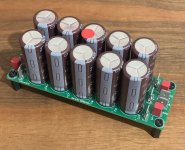 cap bank without diode and pcb tab.jpg428.2 KB · Views: 113
cap bank without diode and pcb tab.jpg428.2 KB · Views: 113 -
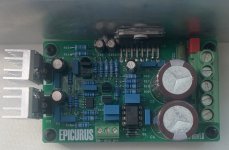 amp2.jpg309.6 KB · Views: 107
amp2.jpg309.6 KB · Views: 107 -
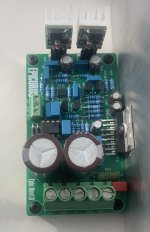 amp3.jpg293.3 KB · Views: 122
amp3.jpg293.3 KB · Views: 122 -
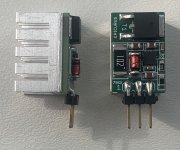 Regulators1.jpg406.9 KB · Views: 126
Regulators1.jpg406.9 KB · Views: 126 -
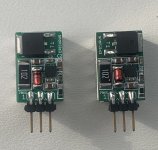 Regulators.jpg511.1 KB · Views: 126
Regulators.jpg511.1 KB · Views: 126 -
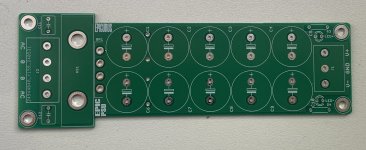 Cap bank pcb witg bridge diode and heatsink.jpg282 KB · Views: 118
Cap bank pcb witg bridge diode and heatsink.jpg282 KB · Views: 118 -
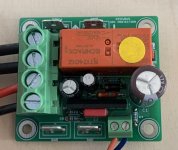 DC offset protection.jpg381.9 KB · Views: 99
DC offset protection.jpg381.9 KB · Views: 99
Last edited:
Very interesting.
I have four of this one - https://www.kaltecs.com/60w-ultra-low-distortion-kit/ , running two in parallel for each channel and I'm absolutely happy with the sound, to my ears better than composite amps based on LM3886 and many much more expensive amps. The measurements are impressive as well - 0.00014% (@1kHz, from 1 to 50W).
Do you have any measurements to share? How is the sound?
I have four of this one - https://www.kaltecs.com/60w-ultra-low-distortion-kit/ , running two in parallel for each channel and I'm absolutely happy with the sound, to my ears better than composite amps based on LM3886 and many much more expensive amps. The measurements are impressive as well - 0.00014% (@1kHz, from 1 to 50W).
Do you have any measurements to share? How is the sound?
Thank you for your interest. These are the measurements I've taken so far. I will share other measurements as soon as possible.
Power: 78W 8ohm (2x42V)
Input sensivity: 1.25V
Slew Rate: 8uV/s 8ohm/1nf (JFE2140)
Slew Rate: 9uV/s 8ohm/1nf (LSK489)
Bandwidth: 5-75khz -3db
DC Offset: <500uV
Gain: 26db
Thd dnr snr will measure…
In general, I like the jfet and mosfet sound. My favorite opamps are Opa1641 opa1655 opa134. opa1611 as BJT... I have listened to many amplifiers made with LM3886 for many years... After making and listening to a famous and expensive LM3886 application, I was very disappointed and thought about what I could do as an alternative to LM3886 with an amplifier ic with Mosfet outputs, and finally I made with such an amplifier. Although the LM3886 seems better in terms of technical data, the TDA7293 is definitely a livelier, more musical and more powerful amplifier... Additionally, I would like to point out; JFE2140 is definitely more balanced and musical than LSK489. Those who like shinny high frequencies may prefer LSK489.
Power: 78W 8ohm (2x42V)
Input sensivity: 1.25V
Slew Rate: 8uV/s 8ohm/1nf (JFE2140)
Slew Rate: 9uV/s 8ohm/1nf (LSK489)
Bandwidth: 5-75khz -3db
DC Offset: <500uV
Gain: 26db
Thd dnr snr will measure…
In general, I like the jfet and mosfet sound. My favorite opamps are Opa1641 opa1655 opa134. opa1611 as BJT... I have listened to many amplifiers made with LM3886 for many years... After making and listening to a famous and expensive LM3886 application, I was very disappointed and thought about what I could do as an alternative to LM3886 with an amplifier ic with Mosfet outputs, and finally I made with such an amplifier. Although the LM3886 seems better in terms of technical data, the TDA7293 is definitely a livelier, more musical and more powerful amplifier... Additionally, I would like to point out; JFE2140 is definitely more balanced and musical than LSK489. Those who like shinny high frequencies may prefer LSK489.
I like your regulators. Do you have the circuit diagram?
Don't you think that 78W output power is way too much. The heatsink must be huge with a really low Rth.
What is the open loop gain of the composite in comparison with TDA7293 alone?
Have you tried to parallel a couple of amps? It might boost the performance.
I think that TDA7293 has an option to connect a second IC chip to increase the output power, something like this - https://www.kaltecs.com/100w-ultra-low-distortion-kit/.
A few words about the sound. The TDA7293 composite amps that I have sound very very different from the conventional TDA7293. They don't have the mosfet sound at all. The most distinguishing feature is that they are socially completely neutral. The difference with LM3886 composite amps is subtle and can't be stopped immediately. The main thing is the absence of listening fatigue of TDA7293 amps.
Don't you think that 78W output power is way too much. The heatsink must be huge with a really low Rth.
What is the open loop gain of the composite in comparison with TDA7293 alone?
Have you tried to parallel a couple of amps? It might boost the performance.
I think that TDA7293 has an option to connect a second IC chip to increase the output power, something like this - https://www.kaltecs.com/100w-ultra-low-distortion-kit/.
A few words about the sound. The TDA7293 composite amps that I have sound very very different from the conventional TDA7293. They don't have the mosfet sound at all. The most distinguishing feature is that they are socially completely neutral. The difference with LM3886 composite amps is subtle and can't be stopped immediately. The main thing is the absence of listening fatigue of TDA7293 amps.
True, compared to LM3886.thing is the absence of listening fatigue of TDA7293 amps.
Yeah, for a short time that is quite true, but from the thermal point of view the IC chip is going to overheat and trigger the thermal protection, unless the heatsink is rather big - Rth < 1.4 K/W.I have seen 25v rms output with 1.25v rms input, it is mean 78.12W 8ohm View attachment 1319562
Have you measured THD?
I like tda7293 sound as well! I would say it has more “black background“ compared to lm3886. More dynamic.
I own two types of lm3886 amps - one is Modulus 86 composite (lm4562+lm3886) and another is four lm3886 in parallel. Interestingly I noticed that if lm3886 is used in a composite arrangement, the sound will not be that of lm3886 itself. It will resembles the sound of the opamp used in the feedback.
Hence I am wondering if you use tda7293 in composite arrangement if you get the sound of whatever opamp is used?
I like tda7293 sound as well! I would say it has more “black background“ compared to lm3886. More dynamic.
I own two types of lm3886 amps - one is Modulus 86 composite (lm4562+lm3886) and another is four lm3886 in parallel. Interestingly I noticed that if lm3886 is used in a composite arrangement, the sound will not be that of lm3886 itself. It will resembles the sound of the opamp used in the feedback.
Hence I am wondering if you use tda7293 in composite arrangement if you get the sound of whatever opamp is used?
Hello; I completely agree with you about Modulus86. Unfortunately modulus86 looks very good on paper but it doesn't sound very good (in my opinion). It's overly analytical and tiring. In composite feedback applications with Modulus86 and LM3886 the character of the input opamp is quite dominant. When I used OPA1656 instead of LME49720 in Modulus86 it became a bit more listenable, but still not very pleasant for me...
For this reason, as someone who likes Mosfet and Jfet sound, I wanted to do something alternative to LM3886 composite applications and the first things that came to my mind were TDA7293 JFE2140 and LSK489-389. When I analyzed the JFE2140 datasheet and LSK489 application notes I decided that the best design to use with TDA7293 is cordell's balanced composite feedback buffer application... As a result I got a great result with a discrete jfet amplifier integrated with a mosfet output...
I tested the JFE2140 and LSK489 on the circuit... The JFE2140 is balanced and has a great sound... LSK489 if you want to hear more shiny and high frequencies. My preference is definitely JFE2140.... I haven't tried it but the LSK389 with its 20pf input capacity might have some tube sound as well....
I will take the measurements as soon as possible.... I'm a little too busy these days.
For this reason, as someone who likes Mosfet and Jfet sound, I wanted to do something alternative to LM3886 composite applications and the first things that came to my mind were TDA7293 JFE2140 and LSK489-389. When I analyzed the JFE2140 datasheet and LSK489 application notes I decided that the best design to use with TDA7293 is cordell's balanced composite feedback buffer application... As a result I got a great result with a discrete jfet amplifier integrated with a mosfet output...
I tested the JFE2140 and LSK489 on the circuit... The JFE2140 is balanced and has a great sound... LSK489 if you want to hear more shiny and high frequencies. My preference is definitely JFE2140.... I haven't tried it but the LSK389 with its 20pf input capacity might have some tube sound as well....
I will take the measurements as soon as possible.... I'm a little too busy these days.
Yes… i will desing parallel pcb and who wants make bridge… before the paralel desing you can try my pcb, and you can find your taste. Because jfe2140 lsk489 have different sound, i am sure lsk389 too…
I listen to this amp with my pcm56 parallel dac iv opa1611 se out… i try jfet iv stage with 2sk2145, it is almost same sound character with jfe2145…
I listen to this amp with my pcm56 parallel dac iv opa1611 se out… i try jfet iv stage with 2sk2145, it is almost same sound character with jfe2145…
Nice indeed, well done!!
One of the contributing factors to the overall relaxing presentation of your amp is the low-noise voltage regs, which is a great distinguishing factor compared to other IC/chip amps.
I am pretty sure I know what all components do... except the IC4... and D1, D2..?? Can you give us a hint??

One of the contributing factors to the overall relaxing presentation of your amp is the low-noise voltage regs, which is a great distinguishing factor compared to other IC/chip amps.
I am pretty sure I know what all components do... except the IC4... and D1, D2..?? Can you give us a hint??
Where? How can we order? Other related details?Board available
- Home
- Amplifiers
- Chip Amps
- TDA7293+JFE2140(LSK489)COMPOSITE FEEDBACK AMPLIFIER